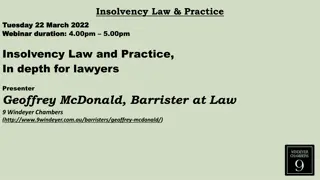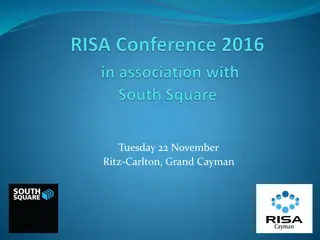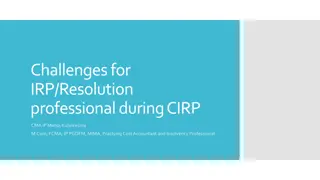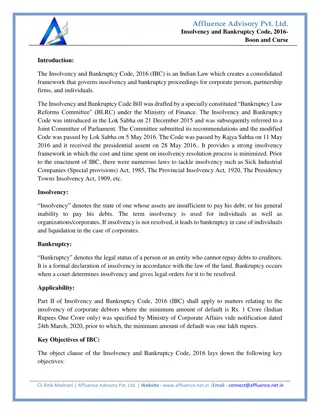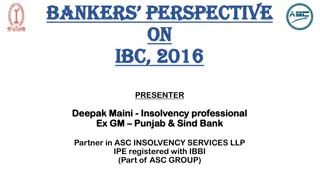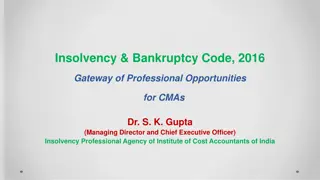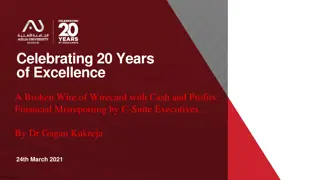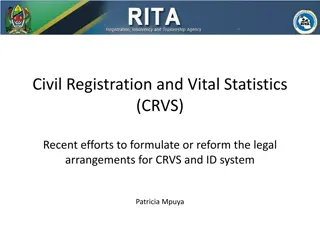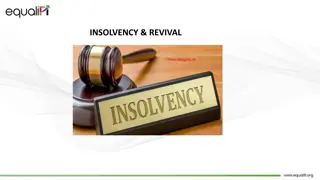Understanding Family Law and Insolvency Intersection at CAIRP Exchange Toronto
Exploring the intersection of family law and insolvency, this presentation discusses common issues such as parenting matters, child and spousal support, division of property, and the definition of a spouse. It delves into the nuances of legal terminology, rights, and claims in cases involving bankrupt individuals. Insightful discussions led by legal experts shed light on the complexities of navigating family law in the context of insolvency.
Download Presentation

Please find below an Image/Link to download the presentation.
The content on the website is provided AS IS for your information and personal use only. It may not be sold, licensed, or shared on other websites without obtaining consent from the author. Download presentation by click this link. If you encounter any issues during the download, it is possible that the publisher has removed the file from their server.
E N D
Presentation Transcript
CAIRP EXCHANGE TORONTO EXCHANGE At the Crossroad of Family Law and Insolvency Julie Zimmerman, Bortolussi Family Law Allan Fogul, Barrister & Solicitor Moderated by Caryl Newbery-Mitchell, CIRP, LIT, MNP Ltd.
CAIRP EXCHANGE TORONTO EXCHANGE Common issues in Family Law matters Issue Claimed against the bankrupt Claimed by the bankrupt 1. Parenting issues, incl. decision making authority (formerly custody ) and parenting time (formerly access ) Generally of minimal relevance to the Trustee other than size of household 2. Child support Potential claim provable; possibly with priority; possibly surviving discharge; and possibly with limited stay of proceedings (ss. 121(4), 136(d.1), 178(1)(b) or (c), 69.41) Trustee generally has no right to the claim,* but amounts received may impact surplus income calculation as income of the bankrupt or the family unit 3. Spousal support 4. Division of property a. Equalization of net family property (in Ontario) Potential claim provable with stay of proceedings; generally does not survive discharge; Vests in trustee, treatment to be discussed later in this presentation a. Ownership of assets b. Disposition of assets Potentially stayed, Trustee may need to become involved if asset has vested; Potential s.81 claim
CAIRP EXCHANGE TORONTO EXCHANGE Who is a spouse ? Family Law Act: 1(1) spouse means either of two persons who, a) are married to each other, or b) have together entered into a marriage that is voidable or void, in good faith on the part of a person relying on this clause to assert any right. For purposes of child support or spousal support under the Family Law Act: 29. spouse means a spouse as defined in subsection 1(1), and in addition includes either of two persons who are not married to each other and have cohabited, a) continuously for a period of not less than three years, or b) in a relationship of some permanence, if they are the parents of a child as set out in section 4 of the Children s Law Reform Act.
CAIRP EXCHANGE TORONTO EXCHANGE Who is a spouse ? Commonly misused terminology Married Divorced Cohabitation 1. Shelter 2. Sexual and Personal Behaviour 3. Services 4. Social 5. Societal 6. Support (economic) 7. Children
CAIRP EXCHANGE TORONTO EXCHANGE Who is a spouse ? Commonly misused terminology Separated A declaration by one or both spouses, with intention, that the relationship has broken down irreparably together with a physical separation.
CAIRP EXCHANGE TORONTO EXCHANGE Bankruptcy Provisions re: related persons For the purposes of this Act, persons are related to each other and are related persons if they are: 4(2)(a) individuals connected by blood relationship, marriage, common-law partnership or adoption; (3)(e) persons are connected by blood relationship if one is the child or other descendant of the other or one is the brother or sister of the other; (f) persons are connected by marriage if one is married to the other or to a person who is connected by blood relationship or adoption to the other; (f.1) persons are connected by common-law partnership if one is in a common-law partnership with the other or with a person who is connected by blood relationship or adoption to the other; and s.2 common-law partner , in relation to an individual, means a person who is cohabiting with the individual in a conjugal relationship, having so cohabited for a period of at least one year;
CAIRP EXCHANGE TORONTO EXCHANGE Bankruptcy Provisions re: related persons 30(4) Sale of property to related parties only with Court authorization Re Clapham (August 11, 2021), Toronto, 31-1453121 (ON SC, Registrar in Bankruptcy) Estranged (separated) spouses are still related to each other. Court approval is required to sell property to the estranged spouse of the bankrupt
CAIRP EXCHANGE TORONTO EXCHANGE Bankruptcy Provisions re: related persons Voting A creditor who is related to the debtor may vote against but not for the acceptance of the proposal. s.54(3) for Division I, s.66.19(2) for Consumer Proposals/Division II. Specified related parties may not vote on appointment of trustee or (except with permission of the court) appointment of inspectors: s.113(3) If the chair is of the opinion that the a vote was determined by the vote of creditor not dealing with the debtor at arm s length during the one year prior to the initial bankruptcy event, the chair shall redetermine the outcome by excluding that vote. Must be appealed to Court within 10 days
CAIRP EXCHANGE TORONTO EXCHANGE Bankruptcy Provisions re: related persons Arm s Length Related persons are deemed not to deal with each other at arm s length while so related. s.4(5) However, this assumption is rebuttable, and it is a question of fact whether related persons were dealing at arm s length at a particular time. Other sections dealing with non-arm s length parties For the purpose of paragraph 95(1)(b) or 96(1)(b), the persons are, in the absence of evidence to the contrary, deemed not to deal with each other at arm s length. No dividend will be to a creditor who entered into a transaction with the debtor before bankruptcy while not at arm s length on a claim arising out of that transaction until all claims of other creditors are satisfied, unless the transaction was in the opinion of the trustee or of the court a proper transaction: s.137(1)
CAIRP EXCHANGE TORONTO EXCHANGE Equalization of net family property Ontario has an equalization regime (not a division of property regime) A monetary obligation is created to generally effect the equal division of the increase of each spouse s wealth during the marriage Ownership of assets is not divided Calculation is based on each spouse s net family property Valued at the date of separation
CAIRP EXCHANGE TORONTO EXCHANGE Spouse A Spouse B At valuation date (separation) ASSETS - LIABILITIES ASSETS - LIABILITIES MINUS MINUS At date of marriage (excludes mat. home) ASSETS - LIABILITIES ASSETS - LIABILITIES MINUS MINUS EXCLUDED PROPERTY EXCLUDED PROPERTY NET FAMILY PROPERTY NET FAMILY PROPERTY
CAIRP EXCHANGE TORONTO EXCHANGE Unique remedies available for Equalization FLA s.9(1) In an application under section 7, the court may order, (d) that, if appropriate to satisfy an obligation imposed by the order, (i) property be transferred to or in trust for or vested in a spouse, whether absolutely, for life or for a term of years, or (ii) any property be partitioned or sold. FLA s.10.1 Division of pension
CAIRP EXCHANGE TORONTO EXCHANGE Equalization Claims in Bankruptcy How can Trustee s deal with equalization claims? Trustee can pursue the claim Trustee can assign the claim back to the bankrupt Negotiate a deal with the bankrupt that they will pursue the claim for some value to the estate; or As unrealizable under s.40(1) Offer the claim under s.38 Trustee can opt to do nothing (up to its discharge)
CAIRP EXCHANGE TORONTO EXCHANGE Equalization Claims in Bankruptcy Rusinek & Associates Inc. v. Arachchilage, 2021 ONCA 112 Can the Trustee commence an equalization claim? An equalization claim is personal as between the spouses under FLA Court of Appeal held that equalization is neither an ordinary claim that the Trustee can commence or pursue, nor a personal claim like pain and suffering which the Trustee can not commence of pursue Equalization, once commenced, can only be pursued by the Trustee it vests in However, the decision to commence an equalization claim lies solely with the spouse
CAIRP EXCHANGE TORONTO EXCHANGE Equalization Claims in Bankruptcy Green v. Green, 2015 ONCA 541 Trustee assigned family law property claims to creditor under s.38 including equalization and a claim to half ownership of island property Creditor assigned its s.38 right in property claims to couple s son for payment of $90,000 Creditor retained amount of its claim plus s.38 costs Paid the surplus to the estate Neither assignee opted to pursue equalization Following her discharge (but no the Trustee s), the wife sought to advance her equalization claim
CAIRP EXCHANGE TORONTO EXCHANGE Equalization Claims in Bankruptcy Green v. Green, 2015 ONCA 541 Trial judge held that the unpursued equalization claim became unrealizable that could be returned to the bankrupt upon discharge On appeal, the Court of Appeal confirmed that the BIA does not provide for automatic return of property upon discharge. A positive act is required to return property. The Court overturned the equalization order
CAIRP EXCHANGE TORONTO EXCHANGE Equalization Claims in Bankruptcy Green v. Green, 2015 ONCA 541 The Court ultimately held that the island property was beneficially owned by the husband and bankrupt wife. The Court was concerned about the s.38 assignment to the son who was effectively aligned with the non-bankrupt father. The Court noted that the son could only take assignment of what rights the creditor had to give. The creditor s s.38 rights only permitted it to retain sufficient funds to pay its claim and its costs. Therefore, the son was not permitted to recover his payment of $90,000, he could not receive a windfall from the sale of the property After payment of the son s $90,000, the proceeds were used to pay the bankruptcy estate in full, and the former bankrupt was entitled to the balance
CAIRP EXCHANGE TORONTO EXCHANGE Equalization Claims in Bankruptcy Kinsella v. Mills, 2017 ONSC 7093 What vests in the Trustee is the right to the equalization claim. It is not a property claim. The Trustee can pursue the claim even if the spouse s assets are exempt.
CAIRP EXCHANGE TORONTO EXCHANGE Equalization: Consideration of debts Zavarella v. Zavarella, 2013 ONCA 720 Wife made an assignment shortly before marriage and was discharged 9 months later The spouses separated 15 years later The wife sought to have her debts valued at $0 at the date of marriage If the wife had $60,000 of debt at the date of marriage and $0 at the date of separation, it would result in an increase in her NFP This would reduce her equalization entitlement by half of that amount
CAIRP EXCHANGE TORONTO EXCHANGE Equalization: Consideration of debts Zavarella v. Zavarella, 2013 ONCA 720 The goal of equalizing spouses net family property at separation is to equally share in the increase in property between marriage and the date of separation If a spouse brings debt into a marriage, it is assumed that the spouses together will pay that debt off during the marriage In this case there was a very low risk that the wife would ever be called upon to repay the debt, and the debt was extinguished without payments ever being made on it
CAIRP EXCHANGE TORONTO EXCHANGE Equalization: Consideration of debts Botcharova v. Kamstra, 2018 ONSC 7204 Wife filed an assignment two years after the date of separation, and was discharged 9 months later Wife did not disclose any of her debts at the valuation (separation) date Wife took the position as in Zavarella that she would never have to pay those debts The Court held in this case that the bankruptcy two years after separation was an unforeseeable event Debts on the valuation date should only be discounted if the evidence indicates that is was probable, on the valuation date, that they would not ever have to be repaid
CAIRP EXCHANGE TORONTO EXCHANGE Equalization: Consideration of debts Jackson v. Jackson, 2013 ONSC 7884 (CanLII) Determined shortly after Zavarella, which was not available to the judge in this case At date of separation, wife had debts of over $110,000 Over two years later, the wife entered into a consumer proposal in which she would pay $27,000 Dispute over which value to use for calculating NFP
CAIRP EXCHANGE TORONTO EXCHANGE Equalization: Consideration of debts Jackson v. Jackson, 2013 ONSC 7884 (CanLII) The Court assessed the test on using hindsight evidence to value assets The Court distinguished between cases where hindsight evidence was used to confirm predictions at the date of valuation (that a debt would never have to be repaid) from the case in Jackson where the hindsight evidence would be used to value the debt, which would be improper The Court permitted the full debt to be included in the wife s NFP Court in MB v. SBB, 2018 ONSC 4893 concurred: The NFP value must be calculated with information available at the valuation date unless the subsequent change was reasonably foreseeable. However, consider the possibility that a filing prior to or shortly after separation might result in debts being excluded from debtor s NFP (negative impact on equalization from the debtor s side)
CAIRP EXCHANGE TORONTO EXCHANGE Transfer at undervalue Mercado Capital Corporation v. Qureshi, 2018 ONCA 711 Wife, who held an MBA, stayed home to care for special needs son who needed around-the-clock care. Trial judge found that the Wife supported the Husband by caring for the children and the household, and the Husband supported the family financially During the marriage, a home was purchased using family savings of $233,500, $50,000 gift from Wife s parents, mortgage; title was taken in Husband s name alone; this property was subsequently sold Second home purchased using sale proceeds of $372,177, $256,240 from the Husband s companies, $89,654 gift from Wife s parents, mortgage; title was taken by the spouses jointly Spouses separated in 2016
CAIRP EXCHANGE TORONTO EXCHANGE Transfer at undervalue Mercado Capital Corporation v. Qureshi, 2018 ONCA 711 Husband adjudged bankrupt in 2016 Soon after, the home was sold; net proceeds of ~$700,000 No Separation Agreement, nor court order, and no formal arrangement for child or spousal support; the proceeds of sale were the Wife s only asset. Creditor (under s.38) brought s.96 claim against wife on the basis of the use of net proceeds from solely-owned first house to buy jointly- owned second house
CAIRP EXCHANGE TORONTO EXCHANGE Transfer at undervalue Mercado Capital Corporation v. Qureshi, 2018 ONCA 711 Trial Judge doubted that he would find a transfer at undervalue occurred, but found it unnecessary to consider, as he would have exercised his equitable discretion to decline to declare the Wife s 50% interest in the home as void, for several reasons: Spouses took title in good faith and did not intend to defeat creditors Wife made substantial non-monetary contribution to the family Wife s parents contributed to the purchase price of both homes Spouses honestly believed that the wife had a 50% interest in the home Wife and children have no other guaranteed form of financial support
CAIRP EXCHANGE TORONTO EXCHANGE Transfer at undervalue Mercado Capital Corporation v. Qureshi, 2018 ONCA 711 On appeal, the Court of Appeal was asked to find the Trial Judge s exercise of discretion in error, but found it unnecessary to review, because it found there to be no transfer at undervalue: Agreement of Purchase and Sale in both names was entered into more than one year before initial bankruptcy event, and this is the relevant date of the transfer s96(1)(b)(ii) The Court did not find intent to defeat creditors, and there was no evidence as to whether the bankrupt was insolvent at the date of the transfer The Court declined to review whether the trial judge erred in exercising his discretion on the basis of its finding that a transfer at undervalue had not been established.
CAIRP EXCHANGE TORONTO EXCHANGE Lifting stay of proceedings (s.69.4) Schreyer v. Schreyer, 2011 SCC 35 Manitoba case (equalization province); family farm (exempt property) Timeline: Date of Separation was1999 Assignment in bankruptcy by the Husband in 2001; discharge in 2002 Equalization ordered in 2008 The Wife argued at the SCC that her equalization claim was a proprietary claim that was not provable; she also argued that she was not given notice of the bankruptcy and so the Husband could not use the discharge against her The Husband argued that the equalization claim is monetary and has been released upon discharged
CAIRP EXCHANGE TORONTO EXCHANGE Lifting stay of proceedings (s.69.4) Schreyer v. Schreyer, 2011 SCC 35 The SCC found that the equalization claim was released and could no longer be enforced against the Husband The provision in the family law legislation that provides how an equalization payment can be made does not convert the monetary claim into a proprietary one If the Wife knew about the bankruptcy, she could have moved prior to discharge to lift the stay under s.69(4) to seek a proprietary family law remedy against the exempt asset
CAIRP EXCHANGE TORONTO EXCHANGE Lifting stay of proceedings (s.69.4) Scott (Re), 2014 ONSC 5566 The Wife brought a motion to lift the s.69.3 stay of proceedings to allow her to continue her claim for a division of property and equalize her bankrupt Husband s pension, RRSPs, and other exempt assets A stay of proceedings can be lifted under 1 of 2 scenarios, pursuant to s. 69.4 of the Bankruptcy and Insolvency Act: (a) Where the creditor or other person is likely to be materially prejudiced by the continuous operation of the stay under s. 69.3; or (b) If it is equitable on other grounds to make such a declaration See also: Paterson v. City of Oshawa, 2023 ONSC 2287 (re: test for lifting the stay generally)
CAIRP EXCHANGE TORONTO EXCHANGE Lifting stay of proceedings (s.69.4) Fiorito v. Wiggins, 2017 ONCA 765 High-conflict case dealing with parenting issues Mother ordered to pay costs to Father of parenting/contempt motion Mother made an assignment Father brought a lift-stay motion to enforce costs award against exempt RRSP
CAIRP EXCHANGE TORONTO EXCHANGE Lifting stay of proceedings (s.69.4) Fiorito v. Wiggins, 2017 ONCA 765 The Motions judge allowed the father to have the stay lifted on the basis of 3 factual findings: 1. Because of the context of 8 years of litigation where the Mother was undermining the Father s parenting and interfered with his relationship with the children; 2. The Mother had paid nothing towards the costs award; and 3. The court and the Father relied on the Mother s representation to the court that she intended to pay the costs and not thwart the payment by making an assignment into bankruptcy The Motions judge found that the Father was likely to receive nothing towards the costs award unless the stay was lifted, and, he was likely to be materially prejudiced by the continued stay Accordingly, the lift-stay remedy allows the creditor spouse to execute any debt against RRSP s; they are only exempt under the bankruptcy regime, not under the provincial property and creditor s rights laws
CAIRP EXCHANGE TORONTO EXCHANGE Lifting stay of proceedings (s.69.4) Mullen (Re), 2016 NSSC 203 In this case, a creditor sought to lift the stay to execute his judgment against the Bankrupt s RRSP As in Ontario, RRSPs are not exempt outside of bankruptcy in N.S. The motion was refused on multiple grounds including that motion was brought post-discharge and the debt released The Court also addressed the concept of lifting the stay to enforce against RRSPs
CAIRP EXCHANGE TORONTO EXCHANGE Lifting stay of proceedings (s.69.4) Mullen (Re), 2016 NSSC 203 Citing Alberta (Attorney General) v. Moloney, 2015 SCC 51: The stay not only ensures that creditors are redirected into the collective proceeding described above, it also ensures that creditors are precluded from seizing property that is exempt from distribution to creditors. This is an important part of the bankrupt s financial rehabilitation Court raised paramountcy issue I cannot be satisfied on material prejudice, equitable grounds, or other grounds because the only prejudice is that which Parliament enacted. [ ] the object of the motion for a stay is to undermine one of Parliament s exemptions. [ ] Mr. Dykens argues that the exemption is unfair. That was for Parliament to decide, not this court. Consider whether the reasoning in this decision might see a case like Fiorito end in a different result
CAIRP EXCHANGE TORONTO EXCHANGE Lifting stay of proceedings (s.69.4) Re Galeano, 2019 ONSC 4984 Parties filed a joint consumer proposal in 2015, but separated in 2016 and could not complete the proposal Later that year, each had filed an assignment in bankruptcy During the bankruptcies, the husband filed for simple divorce which was not contested. The spouses were discharged in 2017 and 2018 respectively. In 2019, the wife commenced an equalization claim
CAIRP EXCHANGE TORONTO EXCHANGE Lifting stay of proceedings (s.69.4) Re Galeano, 2019 ONSC 4984 Court took note that the wife did not pursue the equalization from 2016 until 2018 Wife claimed Husband hid bankruptcy from her, but Court held that after the failed proposal, she could have foreseen that he would have had to deal with his debts and might file bankruptcy Equalization claim was released upon Husband s discharge Wife sought to have the Court declare her equalization claim was not provable or to set aside the Husband s discharge The Court found that the wife s situation resulted from her waiting two and half years to commence her claim and was not prepared to grant the relief sought
CAIRP EXCHANGE TORONTO EXCHANGE Priority of Claims Thibodeau v. Thibodeau, 2011 ONCA 110 Equalization and spousal support, both to be paid out of proceeds of sale of the matrimonial home, resolved by Arbitral Award May 7, 2008 Costs resolved by Arbitral Award September 9, 2008; Award incorporated into Court Order Husband made assignment in bankruptcy October 16, 2008 Wife brought a motion for enforcement, including release of proceeds of sale to her Motion: Granted Wife s equalization claim priority over unsecured creditors claims on the basis that the Arbitral Award created an equitable trust Ordered transfer of RRSP (exempt property) to the Wife to defray her claim to costs
CAIRP EXCHANGE TORONTO EXCHANGE Priority of Claims Thibodeau v. Thibodeau, 2011 ONCA 110 Court of Appeal: The Order that the equalization payment be made out of the Husband s share of the proceeds of sale of the matrimonial home did not create an equitable trust; no priority found The Wife is an unsecured creditor, just like any other The Wife could have moved under s. 9(1)(d) of the FLA for a protective Order, claiming a proprietary interest in the Husband s share of the proceeds of sale The Motion s judge had no authority to transfer Husband s RRSP to defray Wife s costs claim
CAIRP EXCHANGE TORONTO EXCHANGE Priority of Claims Johnston v. Johnston, 2020 ONSC 6515 A Family Court Judge made an order that: The net sale proceeds from the sale of the parties jointly owned matrimonial home shall be held in an interest-bearing trust account by the parties real estate lawyer as security for the Applicant s spousal support claims, in view of the Respondent s dissipation of assets, resistance to a spousal support order and threat of or likelihood of bankruptcy, pending further Court order or the written agreement of the parties. The Respondent subsequently made an assignment in bankruptcy
CAIRP EXCHANGE TORONTO EXCHANGE Priority of Claims Johnston v. Johnston, 2020 ONSC 6515 The Court subsequently made a cost order including directing funds paid out of the sale proceeds. Court had no notice of bankruptcy, and Trustee had no notice of the motion The Court was subsequently asked to determine if the Applicant had security over the sale proceeds in priority to the Trustee on the basis of the order. Court held that the words security for payment for the Applicant s spousal support claims were meant to preserve an asset Not intended to create a security interest in favour of the Applicant The Applicant was not a security creditor for the purposes of the BIA Order made without notice to the Trustee was a nullity.
CAIRP EXCHANGE TORONTO EXCHANGE Discharge Bankruptcy of Vukosav Zivic, 2022 ONSC 3604 Husband filed assignment on May 29, 2015, no prior insolvency events Bankrupt was automatically discharged, but Ex-wife brought a motion to annul the discharge granted on January 5, 2018 Bankrupt misled the Trustee as to her address, then failed to provide her with bankruptcy documents and the Trustee s identity until after discharge Bankrupt failed to disclose assets to the Trustee Ex-wife was given extension to file a notice of opposition Discharge was opposed by Trustee and ex-wife 2 day hearing with a third day of legal submissions The bankruptcy followed a family law decision resulting from a 10-day hearing.
CAIRP EXCHANGE TORONTO EXCHANGE Discharge Bankruptcy of Vukosav Zivic, 2022 ONSC 3604 The Court first considered whether the findings in the family law decisions and in Associate Justice Jean s decision annulling the discharge were res judicata and could not be relitigated. If the suggestion is that at a Bankruptcy Discharge hearing the Bankrupt is free to re-litigate prior Judicially determined, un-appealed issues, that would cause chaos in the Bankruptcy system, and cannot be correct. The decision does appear to have left open the door to the possibility that if new and convincing evidence would be raised that contradicts the prior Court decision, the Court might be prepared to make a contrary finding, but in this case, there was no evidence to refute the original finding.
CAIRP EXCHANGE TORONTO EXCHANGE Discharge Bankruptcy of Vukosav Zivic, 2022 ONSC 3604 Cases the Court strongly relied on: Bobyk, Re, 1995 CanLII 7384 (ON SC) Kozack v. Richter, 1973 CanLII 166 (SCC) Re Richardson, (1998), 5 C.B.R. (4th) 280, 1998 CarswellOnt 3054 Re Matthews, 1993 CanLII 16070 (ON SC) Fundamental message: A voluntary assignment in bankruptcy is not to be used as a convenient way to shed a judgment, especially regarding matrimonial matters. The Court will not countenance the use of the bankruptcy machinery for the primary purpose of evading a debt owing to a spouse; such debts are not analogous to commercial obligations.
CAIRP EXCHANGE TORONTO EXCHANGE Discharge Bankruptcy of Vukosav Zivic, 2022 ONSC 3604 The cases suggest that conditional orders in the range of 70% may be reasonable In Zivic, the Court ordered the Bankrupt be discharged upon paying $170,036.50, being the amount of the equalization claim and amount of the cost order that is not accorded priority as support, approximately 50% of proven claims The condition would be satisfied from any realization including asset recovery or surplus income
CAIRP EXCHANGE TORONTO EXCHANGE Claims surviving discharge Lipinska v. Lipinski, 2011 ONSC 653 Parties entered into a Separation Agreement which, in part, provided for an equalization payment to be made by the Husband to the Wife Order made to pay the unpaid portions of the equalization to the Wife A few days later, before the completion of the motion, Husband filed a consumer proposal that would pay 37 cents on the dollar There was also an amended consumer proposal that would make the Wife a secured creditor for one half of the equalization amount secured by a second mortgage on the home. Unsecured creditors would receive 33 cents on the dollar including other half of wife s claim. Wife would recover 66.5%. Wife rejected the proposal Requested the Court annul the consumer proposa The Court instead converted the lump-sum equalization payment into lump-sum spousal support payment and ordered that a portion of the support would be paid in conformity with the
CAIRP EXCHANGE TORONTO EXCHANGE Claims surviving discharge Lipinska v. Lipinski, 2011 ONSC 653 Contrast this with Davis v. Crawford, 2011 ONCA 294 and Beck v. Beckett, 2011 ONCA 559 the court reaffirmed that a lump sum award should not be made in the guise of support for the purpose of redistributing assets There is a line of Court of Appeal cases to this effect
CAIRP EXCHANGE TORONTO EXCHANGE Costs in family proceedings Generally, for BIA purposes, costs are treated the same as the matter of the proceeding they relate to (i.e. a cost order related to support claims is treated as part of the support order for priority and discharge purposes) Apportionment of costs: Riddell v Lenssen, 2015 ONSC 7953 Taylor v Sist, 2017 ONSC 4280
CAIRP EXCHANGE TORONTO EXCHANGE Domestic Contracts 1. Fulsome financial disclosure 2. Understand the nature and consequences 3. In accordance with the law of contracts
CAIRP EXCHANGE TORONTO EXCHANGE Domestic Contracts Pastoor v. Pastoor, 2007 CanLII 28331 (ON SC) 1. Were the parties represented by counsel or receive legal advice? 2. Was either party disadvantaged at any time during the negotiations? 3. Is there written material or were there oral representations that support a prima facie conclusion that there was a settlement agreement? 4. Is there evidence that the parties intended the written or oral representations or negotiations to be binding on them? 5. Was there an intention that some final act or determination be made before the settlement was to be final and binding? 6. Does the enforcement or non-enforcement of the negotiated resolution result in an injustice to either of the parties? 7. Does enforcement encourage negotiated settlement and discourage litigation and does it support the overall purpose and intent of the principles of the Family Law Act? Family law parties are encouraged to settle their disputes in a reasonable and fair manner without resorting to litigation
CAIRP EXCHANGE TORONTO EXCHANGE Domestic Contracts Shea v. Fraser, 2007 ONCA 224 Equalization payment agreed to in Separation Agreement Husband made assignment in bankruptcy; equalization payment not completed Wife moved to characterize the payment as support Considerations: 1. Could the payment be a substitute for support? 2. Could the debt be traced to a property interest or did it reflect a valuation of an asset? 3. Wording of the Agreement 4. Headings in Agreement not determinative 5. Attributes of the obligation 6. Tax treatment of the payment 7. Subsequent conduct of the parties 8. Policy








